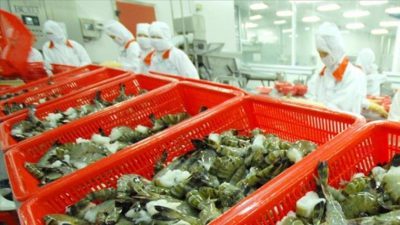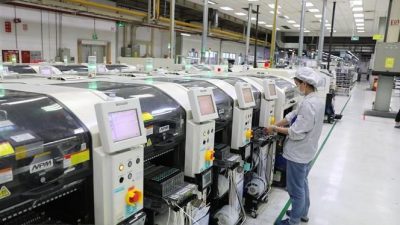This is good news for Vietnam to which trade deficit is always a heady question.
Le Dang Doanh, a renowned economist, commented that the trade surplus has dispelled the concerns that goods and services from ASEAN countries would flood the Vietnamese market as the ASEAN Economic Community (AEC) has taken shape, while the world’s economic growth rate has slowed down.
However, Doanh pointed out that worries still exist.
The problem is that Vietnam has been heavily reliant on FIEs in exporting goods. In other words, all the credit of obtaining trade surplus should go to FIEs, while Vietnamese owned enterprises’ exports were modest.
A report of the Ministry of Industry and Trade (MOIT) showed that Vietnamese enterprises imported more than exported with excess of imports over exports at $2.1 billion. This was offset by an excess of exports over imports by $2.9 billion from FIEs.
| Vietnam witnessed a trade surplus of $865 million in the first two months of the year. However, it was foreign invested enterprises (FIEs) which deserved the credit. |
Tran Dinh Thien, head of the Vietnam Economics Institute, noted that the trade surplus of $865 million could be good news for short term as it created jobs and brought money to the state budget through tax collection.
However, it is not good thing for long-term development, because this shows that the localization ratio in industries has not been improved and Vietnamese enterprises mostly do outsourcing and assembling.
MOIT reported that Vietnam’s farm and seafood exports have recovered with the export turnover of $2.95 billion in the first two months of the year. However, the export turnover of Vietnamese enterprises decreased by $288 million. Meanwhile, FIEs saw export turnover increasing by $806 million.
Of the total export turnover of $10.3 billion in February, the foreign invested economic sector alone made up 70.38 percent, or $7.25 billion.
Experts also pointed out that the trade surplus in the first two months of the year was obtained partially thanks to the sharp decrease in the import turnover of many products. Meanwhile, the decrease in imports, especially machine and equipment imports, showed businesses’ less optimistic production activities.
The report released by the General Department of Customs on February 15 showed that the total import turnover in the first 15 days of February decreased sharply by 48.2 percent, which led to the sharp decrease in the total import/export turnover by February 15 to $33.38 billion, down by 19.4 percent compared with the same period last year.
Bui Trinh, an economist, said Vietnam’s exports rely on FIEs. “We need to rely on domestic enterprises to obtain sustainable trade surplus which can bring long-term benefits to the national economy,” he said.


